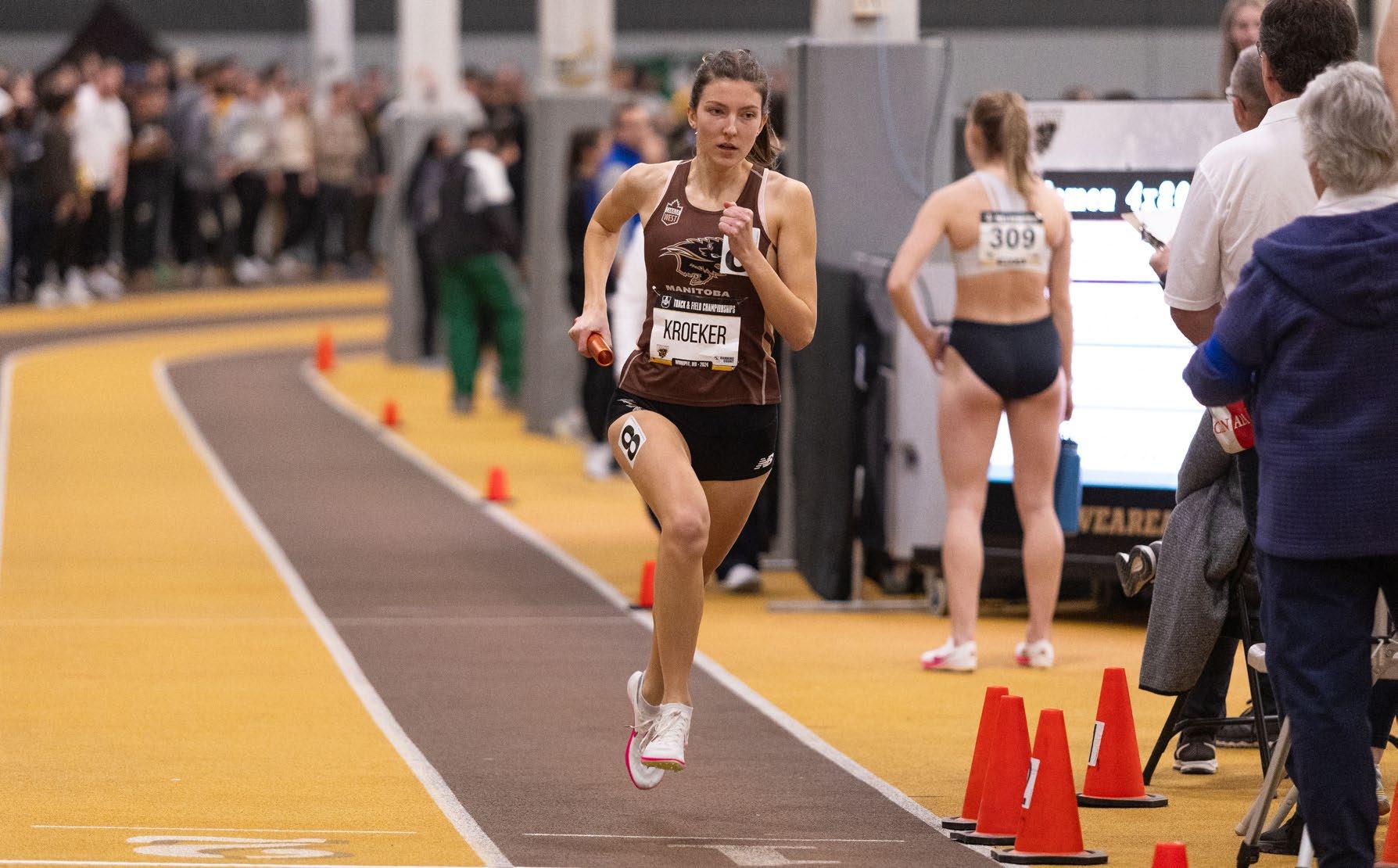










Results for the 2024-25 UMSU general election are in. Divya Sharma, Prahbnoor Singh, Rachhvir Dhaliwal, Bolu Akindele and Carolyn Wang have been elected to make up the executive team for the union next year.
The total turnout for this election was comprised of 16.8 per cent of the 23,675 eligible voters, a drop from last year’s 22.8 per cent of eligible voters, as reported on UMSU’s voting website, simplyvoting.ca.
Sharma won against Joy Okafor in the race for presidency by a margin of 11.4 percentage points, with Sharma gaining 1873 votes, or 55.7 per
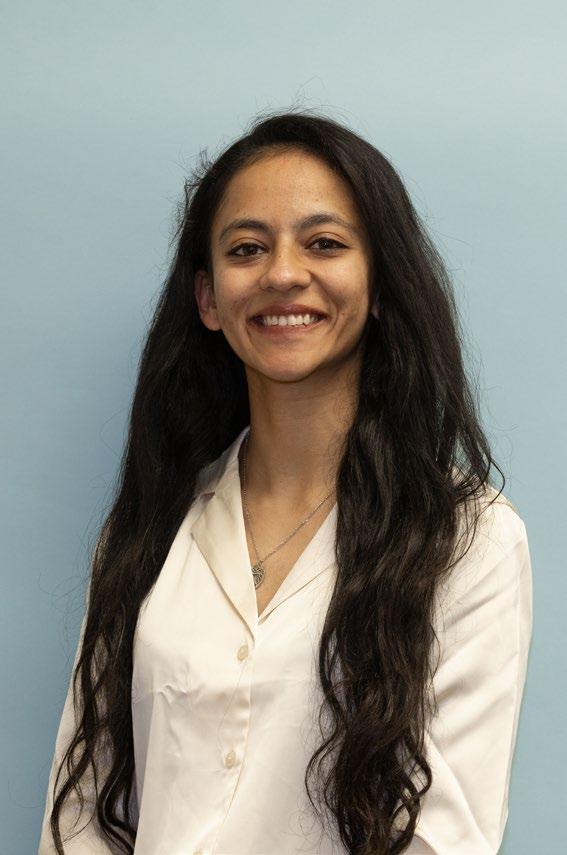
cent of the vote share, and Okafor at 44.3 per cent, or 1489 votes. 620 voters abstained.
Both Singh and Dhaliwal ran unopposed for their titles of vice president external affairs and vice president university affairs respectively, with voters affirming their election with 80.9 and 78.9 per cent of voters voting “yes.”
Singh had 2286 votes in his favour and 1157 abstentions. Dhaliwal earned 2199 votes, with 1194 abstaining.
In the race for vice president student life, Akindele earned 53.9 per cent of the vote share, or 1597 votes, compared to Michael Prokipchuk’s 1367 votes, or 46.1 per cent, earning Akindele the position.

There were 1018 abstentions in this race.
The closest race of the election saw a 5.2 percentage point difference in vote share between Wang and Adil Hayat, with Wang securing 52.5 per cent of the vote, or 1604 votes, and Hayat at 47.5 per cent, or 1449 votes. 929 voters abstained in this race.
Damilola Ojo won 63 per cent of the votes, beating opponent Clifford Emelumba’s 37 per cent in the race for Black students’ representative.
On the ballot unopposed following the disqualification of Dhruvi Shah, Krupa Mashru won the position of

international students’ representative with 79.4 per cent “yes” votes.
86.2 per cent of the votes for racialized students’ representative were in favour of Christabel Attoni-Oteari, who ran unopposed.
“Yes” votes for Michaela de Hoop reached 87.2 per cent, securing her the position of Indigenous students’ representative. De Hoop ran unopposed.
Sole candidate for accessibility community representative Ekamjit Singh won 78.5 per cent “yes” votes.
Heaven Kaur, running unopposed for women’s representative, gained 88.2 per cent votes in her favour.
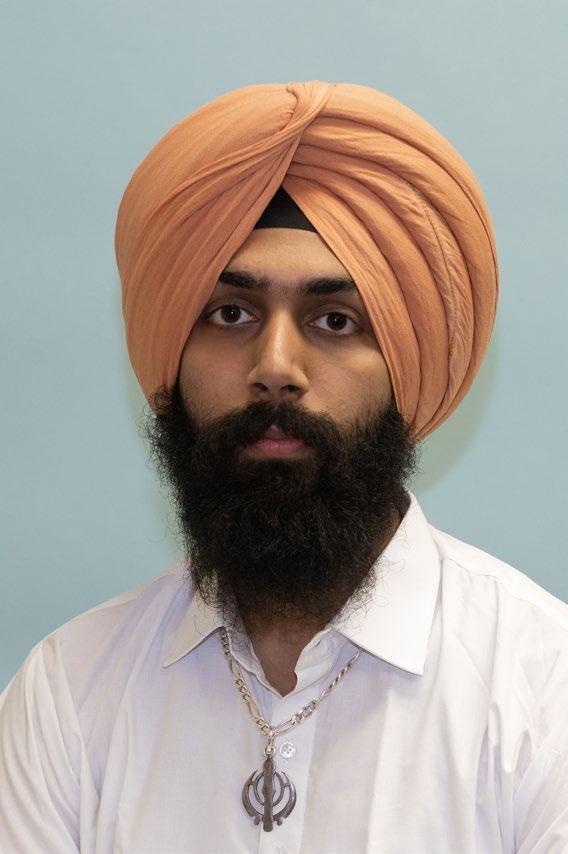


Vol. 110

EDITOR-IN-CHIEF Gillian Brown editor@themanitoban.com
BUSINESS MANAGER Alice Teufack accounts@themanitoban.com
ADVERTISING CO-ORDINATOR Diego Castro ads@themanitoban.com
MANAGING EDITOR vacant me@themanitoban.com
COPY EDITOR Simon Pensato copy@themanitoban.com
COPY ASSOCIATE Paula Samaniego-Ayllon
NEWS EDITOR Sarah Cohen news@themanitoban.com
NEWS EDITOR Colton McKillop news@themanitoban.com
RESEARCH & TECHNOLOGY EDITOR Elah Ajene research@themanitoban.com
COMMENT EDITOR Jessie Krahn comment@themanitoban.com
ARTS & CULTURE EDITOR Jacob Davis arts@themanitoban.com
SPORTS EDITOR Joshua Brandt sports@themanitoban.com
DESIGN EDITOR Taeran An design@themanitoban.com
DESIGN ASSOCIATE Deveney Jarrow
GRAPHICS EDITOR Teegan Gillich graphics@themanitoban.com
GRAPHICS ASSOCIATE Dallin Chicoine
AUDIO EDITOR Harmatpreet Brar audio@themanitoban.com
PHOTO EDITOR Ebunoluwa Akinbo photo@themanitoban.com
PHOTO ASSOCIATE Matthew Merkel
VIDEO EDITOR vacant video@themanitoban.com
SOCIAL MEDIA EDITOR Violet Baker social@themanitoban.com
NEWS Alicia Rose
NEWS Kyra
RESEARCH & TECHNOLOGY Rhea Bhalla
COMMENT Braden Bristow
COMMENT Lakshmisree Shaji
ARTS & CULTURE Kelsey Chin
ARTS & CULTURE Alison Holliday
SPORTS Quinn Mayhew
VOLUNTEER STAFF
Bahareh Rashidi, Christina Tran, Romin Cheema Adam Johnston, Michele Melendez
VOLUNTEER
Madison Beale interested in volunteering? email me@themanitoban.com today!
WINNIPEG, MB
204. 474. 6535
The Manitoban is the official student newspaper of the University of Manitoba. It is published monthly during the summer and each week of regular classes during the academic year by the Manitoban Newspaper Publications Corporation.
The Manitoban is an independent and democratic student organization, open to participation from all students. It exists to serve its readers as students and citizens.
The Manitoban is a member of the Canadian University Press, and our journalistic standards can be found on the Manitoban’s website.
The newspaper’s primary mandate is to report fairly and objectively on issues and events of importance and interest to the students of the University of Manitoba, to provide an open forum for the free expression and exchange of opinions and ideas and to stimulate meaningful debate on issues that affect or would otherwise be of interest to the student body and/ or society in general. The Manitoban serves as a training ground for students interested in any aspect of journalism.
Students and other interested parties are invited to contribute to any section of the newspaper. Please contact the appropriate editor for submission guidelines.
The Manitoban reserves the right to edit all submissions and will not publish any material deemed by its Editorial Board to be discriminatory, racist, sexist, homophobic or transphobic, ableist or libellous.
Opinions expressed in letters and articles are solely those of the authors. Editorials in the Manitoban are signed and represent the opinions of the writer(s), not necessarily those of the Manitoban staff, Editorial Board or the publisher.
A “volunteer staff” member is defined as a person who has had three volunteer articles, photographs or pieces of art of reasonable length and/ or substance published in the current publishing year of the Manitoban.
Any individual who qualifies as a volunteer staff member must be voted in by a majority vote at a Manitoban editorial board meeting. Elected representatives and non-students may be excluded from holding votes as volunteer staff members in accordance with the Manitoban Constitution.
All contents are ©2024 and may not be reprinted without the express written permission of the Editor-in-Chief.
CORRECTION: Guest speaker accused of Islamophobic remarks sparks response, calls for action
In its March 6 issue, the Manitoban incorrectly stated that, at the event featuring Bassem Eid hosted by Students Supporting Israel, a security guard asked the three attendees about a keffiyeh. At the event, it was another attendee who asked them about it, not a member of UM security services.
CORRECTION: Request to hear amendments to motion banning student from UMSU meetings ruled out of order
In its March 6 issue, the Manitoban incorrectly stated that it was the UMSU judicial board that put forward motion 0594. At the board of directors meeting, the union’s executive committee put the motion forward.







Dhruvi Shah, candidate for international students’ representative, was disqualified from the 2024 UMSU general election.
A complaint filed by candidate Krupa Mashru against Shah that led to her disqualification alleges that students associated with Shah’s campaign put a sticker over the image of opponent Mashru on a poster in University Centre.
Shah confirmed that the incident was true when she took to Instagram to announce her disqualification.
Shah wrote that she was present during the incident but claimed it occurred “without [her] knowledge.”
“I had no intention nor idea of the situation,” she wrote.
Although the complaint was originally filed on Feb. 28, this election’s chief returning officer (CRO), Jodie Smith, reopened the case “due to new evidence from security.”
Shah also said in her post that she asked the CRO for further evidence that could
corroborate her non-involvement.
Smith declined a request for an interview from the Manitoban Vice-chair of the elections appeal committee Rohan Sethi said further evidence from security services was given to Smith last Wednesday. She then continued to to “proceed with that complaint” and disqualify Shah.
Sethi said the decision to disqualify her could not be reversed through the appeal process because Shah’s disqualification occurred within 24 hours of the election, but “she still had the opportunity to appeal for the purposes of clearing her name.”
Sethi confirmed that Shah submitted an appeal of the decision on March 7.
The appeal committee sat last Wednesday at 5 p.m. to decide on Shah’s appeal, and found that the evidence brought before it indicated Shah’s responsibility for the actors that vandalized Mashru’s poster. The committee
dismissed Shah’s appeal, and Smith’s decision to disqualify Shah was upheld, said Sethi.
The ruling of the CRO said “defacing a poster in this manner is a form of attack that is not acceptable for any student leader.”
In the decision, Smith also said this was not the first incident where one of Mashru’s campaign posters was defaced
“While I was not able to link the other incidents directly to Dhruvi’s volunteers, I find there is a pattern of targeting Krupa by people who support Dhruvi,” the ruling read.
The Manitoban attempted to reach Shah for additional comment on her disqualification but was unable.
By the time the election period ended, Mashru was on the ballot unopposed.

Kyra campbell, staff
A motion passed by the UMSU board of directors late last year called for the introduction of a ranked ballot system in union elections. This year’s election, however, did not see the change implemented.
After a controversy surrounding the previous UMSU election, there was a recommendation from former governance chair Ivan Nunez Gamez to consider alternative forms of voting.
Victoria Romero, a studentat-large who brought forth the motion, said the decision to keep the current system is “disappointing” as she thought that the change may help “rectify” lost trust, as Romero put it, in the electoral system from last year’s election.
UMSU board member for the Manitoba Law Students’ Association
the current election.
When Dueck assumed the role, he made the decision on Feb. 5 to keep the current system due to the short time frame to implement combined with the time it would take to inform U of M students.
“I made that decision as someone who supports the change,” he said.
Dueck said he is a proponent of the ranked ballot system and voted for electoral reform at governance committee, even as the governance committee recommended against a change in ballot structure. He said the governance committee considered the issue of electoral reform “at length” throughout fall 2023.

“I made that decision as someone who supports the change”
Nathan Dueck assumed the role of governance committee chairperson on Jan. 31 when former chair Michael Prokipchuk stepped away to run in
— Nathan Dueck, acting governance committee chairperson
“If the motion had come 6 months earlier and if I was chair, I would have implemented it,” said Dueck.
Romero said the motion did not indicate an implementa-
tion timeframe. They thought stipulating a timeframe might mean the motion would not pass. After it did pass, Romero expected some kind of change, or expression of “sentiment” about when the process would change.
“It definitely does leave a bad taste in the mouths of voters,” Romero said.
During the Dec. 14 board meeting, Prokipchuk said the election planning was already underway, and that implementation would “create confusion.”
As a lack of education was the main concern for the new system, Romero said that she had expected there to be an education campaign about the current voting system, but that this “still remains to be seen.”
Dueck said once the decision was made to keep the
current system, he could have been more publicly clear about the decision that he delayed the implementation. He said that he wanted a ranked ballot system to be implemented “properly.”
Romero hopes that the lack of implementation for this election does not lead to the issue being neglected in the next academic year. They would like to see a “rough plan” for implementing ranked ballots in the future.
UMSU’s newest project UMSU Ventures has officially launched with the opening of Nabiva Jewelers, run by accounting and management information systems student Tommy Bernabe.
In September 2023, UMSU announced that it would be accepting applications for its new initiative aiming to provide student entrepreneurs with a free space to grow their businesses.
UMSU vice president finance and operations Vaibhav Varma said UMSU had been trying to come up with a use for its flex space across from the service centre.
“One of the big things I’m passionate about and one of the things that I ran on was supporting student entrepreneurs,” said Varma.
Varma said there has been success for student businesses in pop up markets in University Centre, but that those opportunities have always been temporary. He said this program would provide stu-
dents with “a legitimate storefront with high foot traffic,” and “two months of establishing [their] brand.”
To ensure that the application and selection processes were “as unbiased as possible,” the finance committee ranked each business on a number of metrics, including innovativeness, benefit to students and consideration of finances. After each business was ranked, Nabiva Jewelers ended up being the “final candidate.”
One of the main issues that Varma highlighted for student entrepreneurs was the difficulty of finding an affordable space to run their business. Through the UMSU Ventures program, the flex space will be lent to small student businesses for free, allowing for innovation and growth.
“This is really the best place to try new things,” said Tommy Bernabe, the founder and CEO of Nabiva.
Bernabe said he began “conceptualizing” his business during the height of the
COVID-19 pandemic.
“Since I had so much free time, I felt like this would be the perfect time to start something entrepreneurial,” he said.
The pandemic was also a “very isolating” time for Bernabe. Through his mental health struggles, he wanted to make sure his business also had a “social impact.”
Bernabe donates one per cent of proceeds to the Canadian Mental Health Association.
Bernabe saw participating in UMSU Ventures as a chance to step out of his “comfort zone” while also spreading mental health awareness and building his brand.
Bernabe found out he was chosen for UMSU shortly before he was supposed to open, but he said that besides the initial rush, UMSU has been very “responsive” in assisting him with the opening process.
“[We’re] trying to see how we can make sure this really becomes a success for not
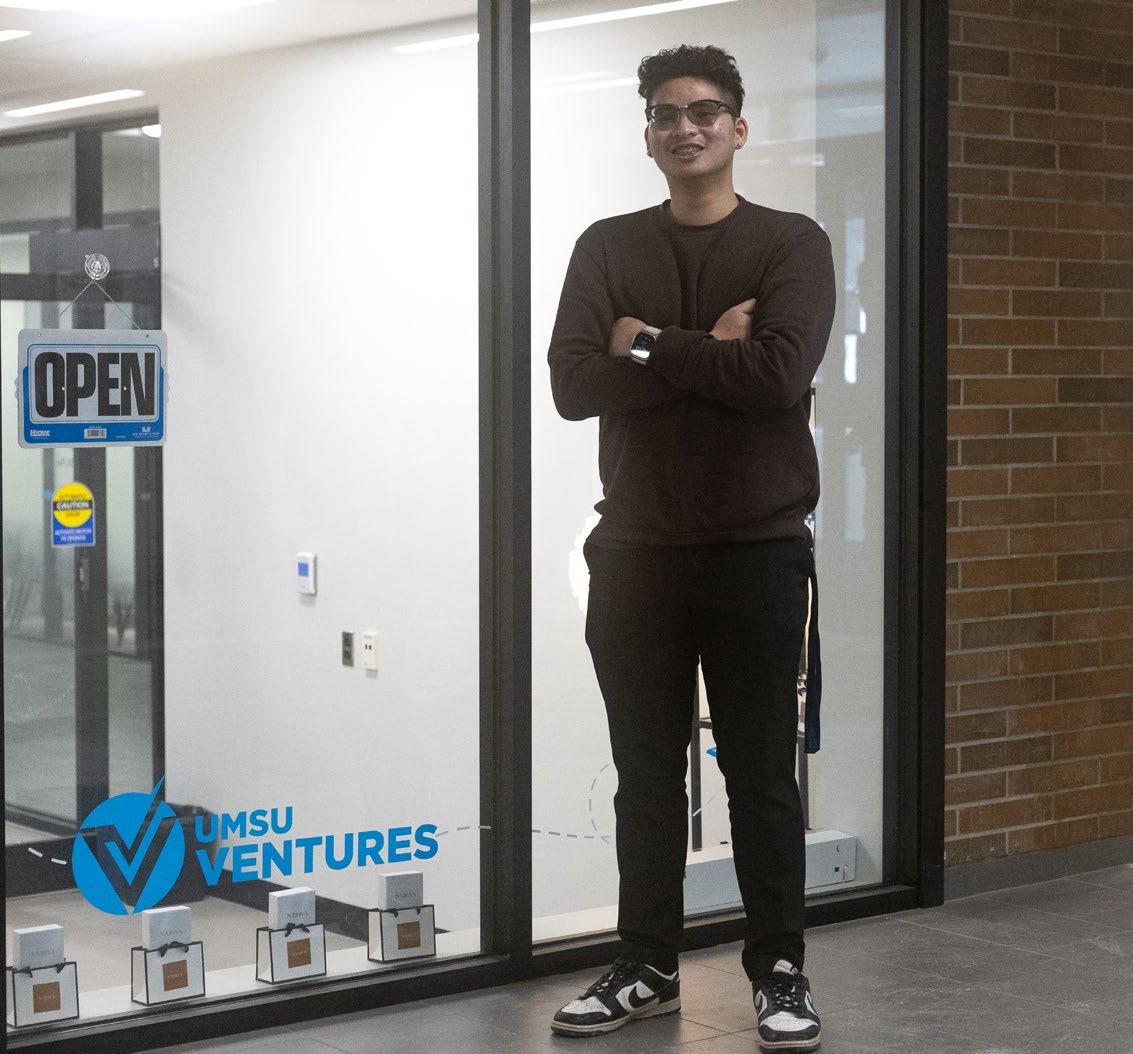
only myself but for future ventures who are in this space,” said Bernabe. To ensure longevity of the program, Varma said that applications will always be open, so that there is always somebody to move into the space right after another business moves out.
“Once I transition my successor, this is something I’m really going to be prioritizing that they continue,” said Varma.
The grand opening of UMSU Ventures will occur on March 18 from 11:30 a.m. to 1 p.m. in 102A University Centre.
rose, staff
The Social Work Students’ Association (SWSA) held a rally in front of Elizabeth Dafoe library last Wednesday in response to concerns raised by group members regarding accessibility.
During a recent SWSA meeting, the group’s accessibility representative raised the issues of people without passes parking in accessible parking stalls on campus, and stairs and railings on campus being inaccessible due to snow.
SWSA representative on the UMSU board of directors Gary Hill said the group “just wanted to raise awareness that this is an issue, there’s people that struggle, and as students, we need to play ball here.”
“It might be a small convenience for you to park in a handicap parking spot, and it’s a major inconvenience for someone with a disability [for others] to be taking that parking spot,” he said.
him, but that when he heard students’ concerns, he agreed more needed to be done.
He said that accessibility is a right, and that people with disabilities or mobility issues “should have every opportunity to be able to come to campus.” He argued these barriers prevent them from exercising the “same right to the education that able bodied people have.”
After bringing the issue to student accessibility services, as well as the associate dean of the faculty of social work, SWSA members decided to raise awareness on the issue themselves. Hill said SWSA held the rally to push for solutions so this “doesn’t continue to be a problem.”


don’t remain “out of sight, out of mind.”
“We just wanted to raise awareness that this is an issue, there’s people that struggle.”
— Gary Hill, UMSU social work student representative
Hill said as a “pretty able-bodied” person, these issues were less obvious to
“During winter in Manitoba, it’s an issue, and we’re running out of winter. Then next year it’s just going to start all over again,” he said.
Hill highlighted the importance of raising awareness on accessibility concerns so they
Hill asked people on campus to be considerate of those who rely on accessibility features. He said he doesn’t “think it’s a big ask” to not park in accessible parking spots, or to clear snow from stairs.
Andréa Espenell, SWSA senior stick and a participant in the rally, said consideration of accessibility should be “part of basic maintenance”
She called the availability of accessible parking stalls “a big issue.”
Espenell said if people see a car without a permit in an accessible parking spot, they should tell accessibility services.
“If more people are sending messages in, they might
become quicker to deal with these issues.”
She highlighted other issues facing those with mobility issues on campus, such as snow clearing.
icons / The Noun Project on campus. She said that she hopes both students and faculty at the university learn more about accessibility issues on campus, and that more people look out for challenges that may affect other students.
“We’ve noticed around campus that the stairs get cleared in the middle, so the railings aren’t actually accessible,” she said.
“It’s dangerous for everybody, but with somebody who has a physical disability, it’s even more dangerous.”

Tristan Miller has always been interested in linguistics and languages.
From a young age, this fascination was sparked by a thoughtful gift from his mother — one of Willard Espy’s books on wordplay.
Delving into the pages, Miller found himself captivated by the endless possibilities and sheer creativity that language offered. As he ventured further into literature, the works of renowned authors like J.R.R. Tolkien, with his intricately crafted languages for fictional worlds, only fueled his curiosity.
Simultaneously, Miller developed a keen interest in computers at an early age and began envisioning a future where these two passions could seamlessly merge.
Miller is one of four new researchers welcomed to the U of M’s department of computer science earlier this year.
His expertise lies in computational linguistics, a field dedicated to enabling computers to comprehend, pro-
cess and generate human language. Through his work, Miller delves into natural language processing and computational linguistics — bridging the gap between linguistic theory and technological advancement.
Computational linguistics encompasses a broad spectrum of applications, from information retrieval algorithms powering search engines like Google to chat systems like ChatGPT. Miller’s research focuses on leveraging computational linguistics to aid linguists in analyzing language theories and generating data for linguistic studies.
One of Miller’s notable research areas is computational humour, where he endeavours to develop algorithms capable of understanding and generating it. Humour, being inherently intertwined with language, poses unique challenges for computational models reliant on statistical patterns.
“If you’re building, say, a virtual assistant, one that you
talk to, it needs to be able to understand when you’re giving a command as a joke and you don’t really want to do it. Or maybe you want the virtual assistant to cheer you up with some humour,” Miller said.
Miller’s approach involves revisiting traditional AI methods while integrating modern techniques to capture the nuances of humour effectively.
An aspect of Miller’s work involves research on translating humour across languages — a daunting task even for human translators.
“When you’re adapting a novel that contains comedy, or a sitcom, or a screenplay, you can’t just literally translate jokes,” Miller said, explaining that cultural references, wordplay and contextual nuances pose formidable challenges during translation.
While computers may not yet fully replicate human wit, Miller believes in their potential to assist translators by identifying subtleties and suggesting creative solutions.
Despite the advancements
in computational linguistics, challenges persist, particularly in adapting models to handle the unpredictability of humour. Humour requires an element of surprise — a facet that conventional models struggle to capture.
“That surprise or unexpectedness is really difficult to capture in a model that’s based entirely on statistics,” Miller said.
Through his work, Miller uses a balanced approach that combines modern statistical methods with rule-based techniques to effectively address surprise in humour comprehension and generation.
When contemplating the future trajectory of computational linguistics and its societal impact, Miller underscored the importance of a nuanced perspective.
While some may fear that advanced language models will render human roles obsolete, Miller believes such concerns are premature. He emphasized the need for a collaborative approach, wherein computers augment rather
than replace human capabilities.
“What we should instead be looking for is how can we best make computers and machines work together so that the computers do what they’re best at and maybe take a load off of some of the more routine but time-consuming parts of a human writer’s job or a translator’s, and still leave the essentially human aspects to the human knowledge worker,” he said.
Miller emphasized the importance of interdisciplinary learning and collaboration in this field, advocating for a blend of linguistic expertise with computational prowess to drive impactful research outcomes. He encourages a holistic understanding of linguistics and computer science, which is essential for unlocking the full potential of computational approaches in language processing.
“It’s so important not to overlook the human element when we’re talking about language processing,” he said.
rhea Bhalla, staff
Ranging from wheelchairs to speech recognition software, over 2.5 billion people globally need assistive technology. As the population ages and noncommunicable diseases become more prevalent, that number is expected to rise to 3.5 billion by 2050.
Amine Choukou, U of M associate professor in the college of rehabilitation sciences, is exploring the potential of assistive technology, or products that help facilitate an individual’s cognitive, communicative or physical functioning. Choukou’s research aims to improve the quality of life of those living with physical and cognitive disabilities by focusing on smart technologies and services.
Today, technology permeates nearly every aspect of our lives. Choukou’s work involves advancing health care by capitalizing on technological innovation.
“People are ready,” he said. “This is a huge opportunity to rethink health care in terms of technology.”
Choukou is the principal investigator of the Rehabilita-
tion Technology Lab.
One of the lab’s current projects is telerehabilitation — a means for health-care providers to assess and deliver therapy to patients remotely. Telerehabilitation has become an especially useful tool since the onset of COVID-19 pandemic, when public health measures made travel to providers’ clinics challenging.
Choukou’s research aims to deliver high-quality care to patients in the comfort of their own homes. Studies have shown that at-home care can be safer and more effective than traditional hospital treatment, especially for patients who are at greater risk for hospital-acquired diseases.
“At the highest level, we can save time, we can save costs, we can save money, and allow the patients to access to care faster,” Choukou said.
“At the individual level, patients don’t need to travel anymore, so they are also saving costs […] they are saving time, and they are increasing the quality of life of the entire family, because if you need care you need someone to drive you back to the hos-
pital.”
Another study co-authored by Choukou found that rehabilitation professionals believe telerehabilitation is useful for supporting older adults at home. Making technology feasible for those with limited digital health literacy or cognitive impairments and training rehabilitation professionals in implementing these programs is crucial.
Choukou is particularly focused on addressing the needs of people in isolated areas and Indigenous communities. Not only do these communities often have reduced access to digital health, but they are often located far from health-care services. His team at the lab developed a tablet-based telerehabilitation program, available in English and Ojibwe, that aims to serve older Indigenous adults and those living on reserves.
Additionally, the lab is working on a camera-based monitoring system for people living with dementia. The system will recognize a patient’s posture and body language without invading their privacy
and identify behaviours that are high-risk. If a patient is engaging in high-risk behaviour, an alert will be sent to care providers to help remove the patient from a potentially unsafe situation.
Another project at the lab is the iManus, a pair of sensorized gloves and therapeutic equipment delivered to patients’ homes, along with a mobile app that allows patients to connect to a therapist. This telerehabilitation technology is used to assist stroke survivors who are living in rural, remote and underserved areas.
The Active@Home program also focuses on helping stroke survivors. With two modes of delivery, participants choose between a mobile app or virtual reality technology. The physical rehabilitation aspect uses a virtual fitness coach who delivers resistance training, stretching and balance training. The cognitive aspect has participants complete activities in a simulated virtual reality environment.
In a case study focused on a rural stroke survivor, Choukou and several co-authors found
that telerehabilitation could be effectively administered remotely. The study was the first to enable the use of virtual reality to practice everyday activities in a digitally generated smart-apartment.
Choukou explained that geographic locations are often tied to socioeconomic status. Those with greater socioeconomic status, and who are living in urban communities, may have improved access to health care and assistive technology.
“At the philosophical level, it’s about equity,” he said. “The end goal of enabling rehabilitation and home-care and supporting this by technology is to provide equity, so every patient receives rehabilitation services the same way across the country.”
At its core, his work is about equity, justice and empowering people wherever they may live. “Don’t think of technology as the end goal,” he said. “Think about the social impact.”

Right now, I find myself in Toronto, teaching people how to make pottery on the wheel.
This process is truly fascinating and holds deep meaning for me. Making vessels is more than just creating something, and teaching pottery has become more than just a job. It is a fulfilling passion that speaks to my soul.
Each day, as I guide my students through the process of crafting bowls on the wheel, I am reminded of the profound connection between art and life. It encompasses the thoughts, emotions and memories of those who have joined in the experience.
The process of making pottery involves creating the pieces, allowing them to dry, trimming and reshaping, then

firing them in the kiln, glazing and firing again. It is a truly time-consuming endeavour. Yet, what makes these times precious is not the process of making each bowl, but the experiences and moments shared along the way. Even in

the middle of my busy daily life, this process holds significant value for me. A handcrafted piece is not just a functional object it is intricately connected to our lives, embodying our thoughts and emotions.
Pottery teaches me the importance of slowing down. Day by day, my hands move in a repetitive motion until the form takes shape. This process is imbued with tranquility and calmness. Pausing from our busy lives to create

something meaningful from the clay is like an artist painting on a canvas.
Once it is finished, the piece becomes a container for our thoughts and feelings. A handmade creation is a real link to our lives, carrying with it special memories. Even in a world that is always changing, we can feel comfort and steadiness in the slow making of bowls. Crafting things is like taking a journey into our hearts.
So as I sit at the wheel, hands covered in clay, I am reminded of the beauty and simplicity of life. And I am grateful for the opportunity to share that beauty with others.



Having lived through UMFA’S 2016 and 2021 strikes as an undergraduate and as a graduate student, I like to keep my ear to the ground about labour disputes in other post-secondary institutions across Canada. Early March is bargaining season for unions at post-secondary institutions across Canada, so the first week of the month played out like a sordid gumball machine bleakly dispensing news of obstinate employers.
A small university in Halifax recently went through a low-profile struggle that was nonetheless significant. Mount Saint Vincent University Faculty Association (MSVUFA) saw the end of the longest strike in the association’s history on March 5.
Around Canada, the first week of March rang in a wave of potential strike actions just a few days out from the end of MSVUFA’s.
In Toronto, negotiations between the University of Toronto and two locals of the Canadian Union of Public Employees (CUPE) 3261 and CUPE 3902 went down to the wire. CUPE reached an agreement with the U of T just minutes before the strike date of March 4.
The unions, which represent the bulk of U of T’s teaching assistants, service workers and contract lecturers, among others, landed wage increases and a commitment from the employer to seek a 45 per cent discount on transit for union members in Toronto, and much more.
After voting to strike on Feb. 10, the Brandon University Faculty Association (BUFA) was set to strike starting Monday, March 4. The Brandon Sun reported the strike was averted when “inroads” were made as Brandon University continued to bargain with BUFA.
These sorts of partial, hairbreadth success stories can skew the picture of labour rights movements in Canadian universities right now. Workers at several other places of higher learning are, in this very moment, fighting for their labour rights with no immediate promise of a win.
On the horizon, the Lec-
turers’ Union of Memorial University of Newfoundland (LUMUN), a union of contract lecturers and post-doctoral fellows, has issued a strike mandate to its employer, Memorial University of Newfoundland, as of March 4.
Currently, LUMUN lecturers earn $5,000 per three courses they teach. This means that, if a lecturer teaches three classes per semester for the fall and winter terms, they would be earning $9,200 less than a minimum wage worker in Newfoundland and Labrador would by working 40 hours a week for 8 months of the year at $15 an hour.
Of course, as all educators know, teaching even one class can eat up all one’s free time depending on how trigger-happy students are with sending frantic, late-night emails in caffeine-fuelled frenzies. $5,000 compensation definitely does not equate to minimum wage if we factor in the amount of actual work instructors are likely doing.
What incentive is there to take this work on when you can earn more working regular hours at McDonald’s?
All of these actions are either resolved or in the future, but CUPE 3903, a union of sessional instructors and TAs largely populated by
graduate students at York University, is on its third week of striking as of March 11.
The union’s last strike in 2018 famously dragged on for close to 5 months, at which point the Ontario Progressive Conservative government issued back-to-work legislation.
The 2024 strike is not looking much brighter, as CUPE 3903’s X (formerly known as Twitter) account posted that Toronto police arrested one picketer on March 4 for setting up the picket line.
Looking at these disputes as a gestalt reveals a pattern. Tuition is increasing across Canada while universities send down ordinances that their employees must tighten their belts. When unions decide to or do exercise their rights to strike in response, they’re met with record-breaking greed from their employer or the threat of police violence.
Students, for their part, are usually frustrated during strikes, reacting with hostility and even, on occasion, violence towards striking labourers. Some of my own friends who
have gone on strike at different universities around the country have shared horror stories from the picket line of undergraduates hurling hot coffee at them or grabbing strike paraphernalia and hitting picketers.
Of course, there are undergraduate students who sympathize with strikers, but are still left with the same frustrations. Tuition increases either way, and this increase never feels like it bears fruit in a higher quality education.
No matter what, academic strikes revive the mantra that the people who are really getting shafted are students.
But what this perspective ignores in CUPE 3903’s case is a significant portion of the membership are students who, just like undergrads, have to deal with increasing tuition. Large portions of graduate students’ funding are tied to their TAships, which at York pay just over $12,000 per year. This wage is a grotesque pittance in the Greater Toronto Area, where rent for even a modest one-bedroom apartment has blown past $2,500 per month.
U of M’s locality. None of our unions are striking, so why think about strikes right now?
UMFA’s collective agreement with the U of M expires on March 31, 2024. The turnover in undergraduate populations is around 4 years, so the sort of institutional memory of the 2021 strike that helps students understand why supporting strikers is important has likely faded in no small measure. U of M students who might be around next year should think about where to place their support if and when any of the U of M’s unions go on strike.
What’s more, we should be thinking about why UMSU hasn’t organized a strike for its own part. The union’s inefficacy over the years in the face of rising tuition, the revocation of international students’ healthcare and the censorship of students who criticize the genocide of Palestinians have proven UMSU is grossly disengaged from real political issues.
This means that CUPE workers deal with both the university’s aversion to paying its employees and the university’s avaricious approach pricing education. CUPE 3903’s strike is fundamentally an issue of students’ rights.
These struggles might seem irrelevant to the

More than 20,000 Concordia and McGill students will be striking proposed tuition increases in Quebec for out-of-province and international students — students from France and Belgium alone are exempt. This sort of tangible action is something UMSU execs never even promise as they campaign, let alone engage in when they do enter office.
History suggests present U of M students need to brace themselves for the possibility that a strike could happen during the course of their degrees. Look to strike actions happening at other universities right now and think tactically about what to do if you experience the same thing.
Tracy Karuhogo’s tenure as UMSU president has been marred, just like her predecessors’, by a general ineffectuality and callously turning away from issues that really matter. As Divya Sharma takes up her mantle and the potential need for UMSU to show solidarity looms, U of M students need to push union leadership to do more for students’ rights than post links on Instagram inviting students to seek mental health resources when it’s time to take action.
The results are in, and UMSU’s newly elected executive team for 2024-25 has been decided.
Among the elects, Divya Sharma, the incoming president and incumbent vice president community engagement, campaigned on the goal of reinstating free international student health care.
In a North American political context, conversations around health care certainly point to the need for better structural support that acknowledges the difficulties faced by those who are constantly shoved to the sides of society, living with minimum rights and meeting bare minimum needs.
Compared to our neighbouring country, the U.S., we have a slightly better, publicly-funded health care system in Canada, where some roles and responsibilities for services are shared between provincial and territorial governments and the federal government.
However, the health-care system in North America has been a topic of debate for a long time, as it fails to provide adequate support to many minorities and marginalized groups. An August 2021 report by The Commonwealth Fund compared health care in the U.S. to 10 other high-income countries, with Canada ranking 10th and the US ranking 11th. Norway, the Netherlands and Australia ranked better in five categories, including access to care and administrative efficiency.
We need to have serious conversations about why Canada has ranked so low and what that means for students and others who belong to the precariat class.
In 2018, the Manitoba Progressive Conservative government cut universal health coverage for international students to save approximately
$3.1 million. Since then, international students have had to pay $1,032 annually to replace the coverage.
This move has put international students at a disadvantage, as they are already paying more than double the tuition fees that domestic students pay and living far from their home countries, often without the support of a community in the country they have immigrated to. While the Manitoba New Democratic Party vowed to reinstate international student health care coverage, solid actions have yet to be taken.
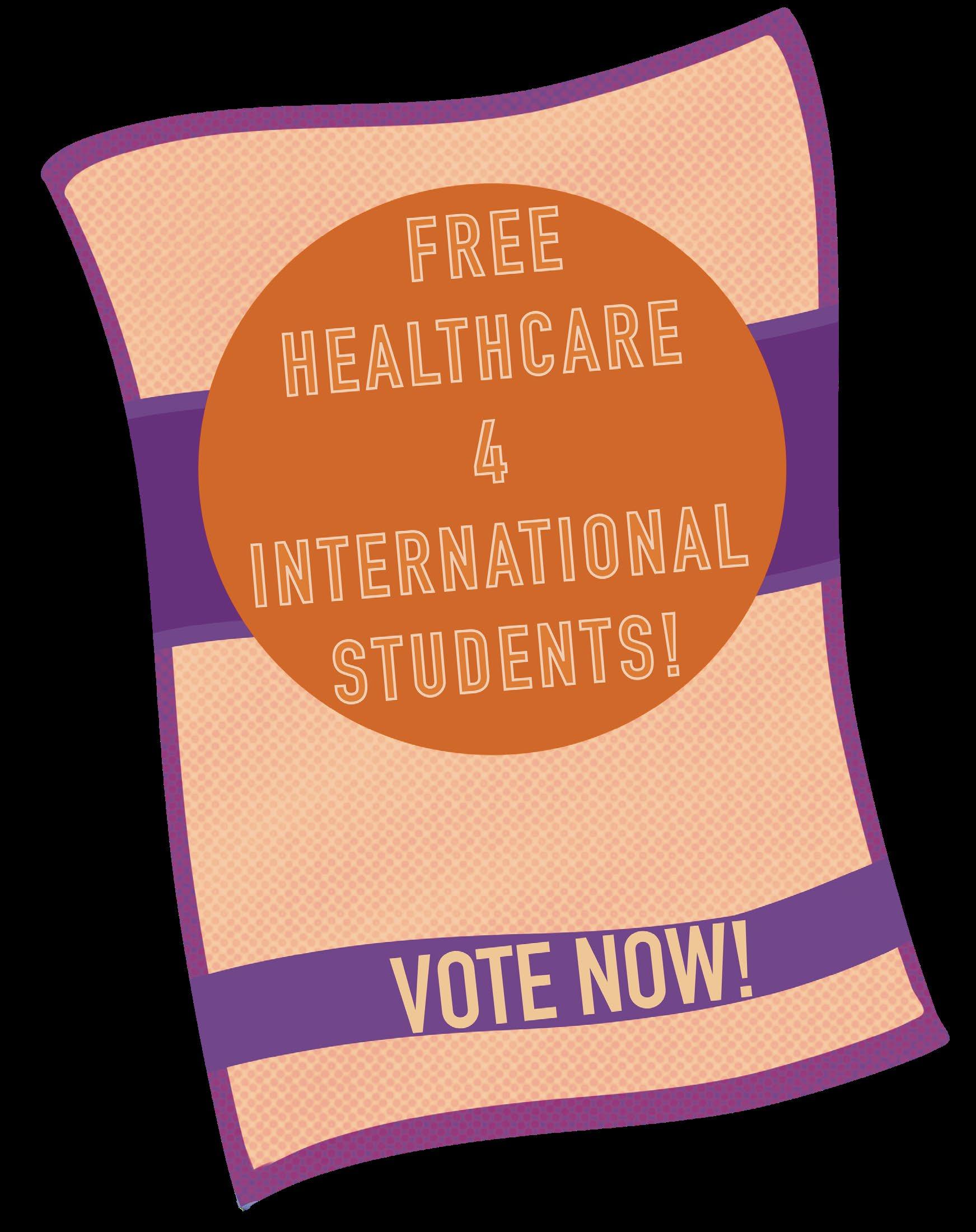
health care for international students, bear so much importance in the political contexts of Manitoba and Canada. COVID-19 has posed unprecedented threats to the medical care system globally, and we have so much to do to be able to build a system that can accommodate needs that go beyond the expected limit.
UMSU’s new executive team, and their promises to counter the rescindment of
Part of preparing for things like that is paying attention and care to the needs of the precariat class. Through the Manitoba International Student Health Plan, students
have access to primary health coverage, such as seeing a physician at a clinic or hospital. However, efficient health care includes access to a community that ensures care and love.
When I first came to Canada, I registered in U of M’s International Centre Welcome Mentors program, through which I found my mentor, who is now one of my close friends. My mentor, having grown up in Winnipeg, knew everything about the city and the university. She helped me adjust to the environment and gave me strong support dur-
ing my initial days here. I was welcomed with a bag full of toques, scarves and other winter essentials. She also gave me guidance on finding doctors and accessing medical care if need be.
While this is certainly something not every mentor might need to do, I appreciate having support systems like this, organized by the university. My example shows what we can do as all of us students are in great need of care that is inclusive of both physical and mental well-being.
I’m a firm believer that student unions can contribute towards the betterment of society and that they should be actively partaking in the conversations around student welfare. Unions have the potential to build communities, provide care and implement structural changes. They address concerns that the government overlooks.
If we wish to be part of an institution and union that truly cares about its students, we must keep having conversations about equal rights for all, starting with health care. These conversations should include the political history of the country that has systemically reduced access to health care for Indigenous people. The medical practices influenced by anti-Indigenous racism and added systemic disadvantages have caused Indigenous people to be unable to access decent health care.
This problem, since it is rooted in a colonial and capitalist system, extends to others who are directly affected by the injustices, like the 2SLGBTQIA+ community, racialized communities and international students.
UMSU should acknowledge that these conversations are central to making health care accessible for everyone.

To complete Sudoku, fill the board by entering numbers 1 to 9 such that each row, column, and 3x3 box contains every number uniquely. In Straights, like Sudoku, no single number 1 to 9 can repeat in any row or column. But rows and columns are divided by black squares into compartments. Each compartment must form a “straight.” A straight is a set of numbers with no gaps but it can be in any order, eg [7,6,9,8]. Clues in black cells remove that number as an option in that row and column, and are not part of any straight. Glance at the solution to see how “straights” are formed.

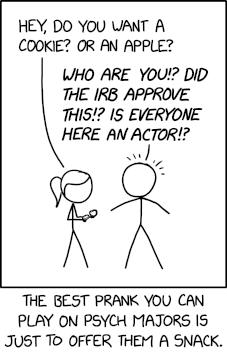

The University of Mani-
toba campuses are wide, sprawling and sometimes inhospitable.
For students looking for connections, either in scholarly or creative environments, options for socializing are limited to what is provided by other students who have their own unique schedules, causing group drop-in times to vary.
Hanako Teranishi, a fourthyear English honours student, is aiming to remedy that with their new group, UM Student Writers.
The group is open to all students from all faculties and to anyone who just wants to write and meet other student writers.
“In university, there are limited spaces to sit and be without certain rules and restrictions,” said Teranishi.
This lack of a third space — a space aside from home and the workplace — to exist and connect inspired Teranishi to create one for anyone who has writing to get done.
Last year, Teranishi found themselves getting involved in campus communities and events through the University of Manitoba Institute for the Humanities. Despite the fact these events were open to everyone, Teranishi noticed a lack of students amongst the attendees.
“Even in finding those communities, there was still a huge lack of student community,” Teranishi said.
Teranishi found that the offered student groups required more work than they were able to do, and struggled to accommodate it into their schedule.
“I thought it would be nice to do something that meets me at my own level.”
Through this desire, the UM student writing group was born.
Inspired by the writing group run by Jocelyn Thorpe, director of the Centre for Creative Writing and Oral Culture and U of M associate professor in the women’s and gender studies program and department of history, Ter-
anishi’s group aims to be student-based, fostering a collaborative community.
Teranishi hopes to cultivate “a space where undergrads and grad students can come and sit in a space for a couple hours and write together.”
Any writing, or even reading, will be encouraged in the group. Teranishi personally wants to dedicate the time to their own creative work.
Teranishi hopes the group will provide a low-pressure environment for the campus community to begin and grow.
Community in third spaces emphasizes casual connections and their importance for mental health. In this same vein, Teranishi encourages people to create a wider community at the university to engage with groups of people you can just be with.
“To be around others is really great for mental health,” Teranishi said. “I really want this space to be centred around […] support for one another.”
For more involved students, Teranishi hopes to provide an

option to submit work for a published text of works from the group. Teranishi wants group members to be open to “sharing space physically but also sharing space on a page.”
At the end of the day, Teranishi said that they “really want this place to be a place of care and community.”
4/5 Stars
Bombay Bicycle Club and I have a complicated relationship.
I never talk about them being a favourite of mine when in heated discussions about music. In fact, I often forget about them entirely when suggesting music to others.
Yet several of their albums have accompanied me through such pivotal moments in my life, and every time I revisit their work, I am always impressed and moved.
When listening to their latest EP Fantasies, released Feb. 23, I was expecting to hear a completely unfamiliar sound that comes naturally with musicians as time goes on, the expected evolution of artists.
However, I was pleasantly surprised with how Bombay Bicycle Club yet again subverted my expectations with this EP.
Fantasies contains four tracks with four different fea-
tured musicians collaborating on them, Matilda Mann, Liz Lawrence, Lucy Rose and Rae Morris.
The EP leans heavily into the dreamy sounds of two other albums in their discography, which happen to be my favourites, Everything Else Has Gone Wrong and A Different Kind of Fix
There’s the slightly faster-paced beat and bass of Everything Else Has Gone Wrong but with the blended ethereality of A Different Kind of Fix
Despite these similarities, however, Bombay Bicycle Club is trying to chart a course into a sound that, while paying homage to its roots, needs to take its own path, and I can respect and see that in Fantasies with how much more airy it sounds.
Perhaps it’s the xylophone, which takes centre stage, in the third track on the album.
Though I would never really consider the music the band made previously as heavy, the EP manages to retroactively leave that impression with
how bright and uplifting it sounds, particularly with my favourite and last song on the track list, “Better Now (feat. Rae Morris).”
With fast-paced basslines matched with soft ethereal vocals, I found myself nodding my head in time almost immediately with the chorus and the striking imagery provoked — “All rise with me like burning suns you’re asking me where I’m coming from.”
All in all, while activating some nostalgia for hot summers and first dates, the EP calls back to previous favourite tracks — one of which I’ve put on a “Basement Mixtapes for Bisons” playlist in the past. Fantasies branches out from albums of the past to provide a light and warm soundtrack that feels joyous and hopeful.
A testimony to the indomitable human spirit and its ability to keep going no matter what.
The group will have its first meeting on March 21 at St John’s College with light refreshments and snacks available. The group hopes to meet every Thursday. Students can keep up to date with @umstudentwriting on Instagram.

A testimony to the indomitable human spirit and its ability to keep going no matter what
S ometimes failure closes doors, and other times it starts podcasts.
A year after leaving a tech startup job to dedicate her career to art, Madison Beale, a U of M student studying art history, realized just how much she had learnt from the simple act of talking to people.
Looking for a way to share the knowledge she was gaining, Beale created her podcast The Artalogue
Her project is dedicated to making the information and conversations around careers in the visual arts accessible for everyone.
“I wanted to create a community and platform where people would be able to access the conversations I was having,” Beale told the Manitoban.
With no prior podcasting experience besides the fact that, Beale says, she “love[s] to yap,” Beale set out to fill a gap in the podcast market. The Artalogue is a podcast with a conversational format where established and emerging artists have conversations about their different careers.
Beale chose the podcast format because it offers a way to “chill out and learn something new.”
With ten episodes released, Beale has interviewed painters, photographers, multimedia artists and an art history meme account admin. She connects with these artists through personal meetings, mutual connections or reaching out via social media or email.
Despite what Beale calls “the humbling experience of being left on read,” she continues to learn with every interaction. Beale hopes to feature more artists in the future, including installation workers, set designers and filmmakers.
“I just try to keep it as broad as possible so as to not close myself in. If I want to speak to someone […] why not have them on the podcast?” she explained.
Beale hopes this eclectic collection of artists provides a positive future for art students and battles any feelings of dejection by putting forward stories of different successful and rewarding careers.
For any students who are not involved in the arts yet find themselves curious about it, or for those who “touch paintings when the guards aren’t looking” — Beale hopes to make it clear that it is never too late to switch to some-
thing new.
“If you’re on track for what you want, great. If not, take a gander, see what else is out there.”
After the personal experience of leaving her studies at the University of Exeter and, later, working at a tech start-up, Beale found herself worrying that, despite her unhappiness, leaving those spaces would be a failure.
However, a year after making the choice to pivot to art, Beale looks back on that choice in a much different light.
“It’s not so much a failure as it is a change of direction.”
This new attitude towards failure applies to every aspect of Beale’s life. Now studying at the U of M, Beale praises her teachers and professors for their intelligence and for, in some cases, agreeing to come on the podcast.
She applies this resilience to her grades in her classes. They are no longer consequential moments but rather a “springboard for improvement.”
“I see failure as an opportunity to learn,” Beale said.
“I think that everyone is going to fail miserably and fantastically and in so many ways at so many different points in their lives.”

After changing directions in studies, beginning work at a gallery and learning how to run a podcast on her own, Beale expressed feeling happier than she was before.
“I’m a million times happier doing what I love and trying and failing and doing all these things than I was playing it safe.”
The mission of the podcast, Beale emphasized, is to have people involved with art as a whole. From learning how to apply for grants, discovering
new artists or even just getting involved with the Winnipeg art scene, Beale wants people to know “it is never too late to get involved.”
To become a “friend of the pod,” search The Artalogue on all major podcasting networks. Keep up to date with the podcast and blog at @ artaloguepod on Instagram or at the website https://artalogue.podcastpage.io/

Sports, the people who play them, and the community fostered around them, have always fascinated me. As a queer person, getting involved in sports organizations both in and out of the closet can be an experience fraught with tension — a tension that has been mounting exponentially in recent years.
Following policies introduced in Alberta that aim to ban transgender women from participating in women’s sports leagues, I set out to learn more about how sports organizations on campus are creating explicitly inclusive and queer-friendly spaces.
U of Them is creating just that kind of space. The group has a dedicated bouldering night where women, nonbinary and gender non-conforming people get together to climb at the University of Manitoba. It has been running for roughly one year and is not affiliated with the U of M climbing club.
I joined six people, including Kirstyn Eckhardt, one of the Active Living Centre’s rotating climbing gym instructors, who went to check it out recently. Of the five other participants, Mary Lil-
lington and Leia Hermesdorf were regulars, Hanako Teranishi was a returning climber while two alumni, Chelsea and James Mckee-Trenchard, joined for the first time.
Eckhardt said that U of Them is a “quieter space” and “a safer space for [people] to climb and feel welcome.” She noted that people “typically come in pairs,” but some show up on their own as well
The group is open to climbers of all experience levels and is “good at welcoming people,” she added. “People have improved in their climbing and are making friends here.”
The climbers expressed varying levels of intimidation and discomfort when climbing in mixed spaces. Reasons for this discomfort ranged from a lack of women in the climbing spaces to perceived judgement towards form and approach. “I knew it was going to be a safer spot,” Teranishi told me, “because it would be [a] queer and woman-designated space.”
Hermesdorf said the relaxed and supportive atmosphere was one of U of Them’s draws.
Chelsea pointed out that we were talking about the need
for queer-friendly spaces mere days after the death of Nex Benedict, a trans, nonbinary teenager from Oklahoma, U.S. who was beaten by schoolmates in a women’s bathroom and died the next day.
Teranishi reiterated how concerning it has been to see anti-trans rhetoric in the province, as in last year’s protests against 2SLGBTQIA+ inclusive programming in schools.
Eckhardt said that a pride flag sticker had been removed from the climbing room’s door facing the hallway, which was a “very upsetting” experience.
Among the benefits of climbing, Hermesdorf and Teranishi emphasized the role of the activity in building muscle and combating gender dysphoria. Lillington, Hermesdorf and Teranishi reiterated the mental health benefits of staying active as well.
After our interviews, the climbers invited me to join them. They cheered me on as I scaled an easy route and dropped to the floor when I was done, as recommended to newcomers.
Participating in a U of Them climbing session made me eager to go back and climb in a space I knew I was welcome

in. At the end of the session, we joked about the substantial overlap between climbers and queer people. Even the climbing holds were rainbow coloured.
It feels like now, more than ever, fun and inclusive spaces are needed on campus, where people can simply exist and try something new.
“People just want to be together and be with community,” Teranishi said.
The University of Manitoba women’s volleyball team squared off against the University of British Columbia (UBC) Thunderbirds this past weekend in the CanWest championship final. Both schools dominated the CanWest volleyball standings all season long, finishing second and first respectively.
Moreover, in regular season play, each team beat the other once.
As the Thunderbirds finished atop the CanWest regular season standings, the game was played on UBC’s home court — War Memorial Gymnasium in Vancouver, B.C.
It would seem only natural, then, that these two volleyball titans would go on to play one of the most entertaining championship games in recent memory.
In the first set, the Bisons came out on fire. Led by the
orchestration of first-team CanWest all-star Katreena Bentley, the Bisons’ offence looked fluid and dangerous.
Capitalizing on its great start, the Bisons nabbed a stellar first-set victory, 25-17, which was capped off by a thunderous Light Uchechukwu kill.
The Bisons blitzed UBC in the second set as well, leading by as much as 11 before closing it out 25-17, this time on a UBC service error.
In the third, the T-birds clawed back into the match even though, at one point, the herd nursed a 24-22 matchpoint lead. Ultimately, some clutch hitting from Morris, Man.’s own Erika Vermette allowed UBC to scrape a narrow 26-24 third-set victory.
In the fourth, the herd led by a considerable margin once
again. However, UBC came back, erasing a late 22-19 deficit to win 25-23.
In the decisive, winnertake-all fifth set, it was UBC who got off to a good start. Leading the herd 4-0 early, it seemed as though the Bisons were on the precipice of collapse.
Nevertheless, as UBC had done in the previous two sets, the herd mounted a comeback.
Finished off by a couple of excellent Ella Gray kills, the herd eluded a UBC comeback with a 15-12 fifth-set victory and won the CanWest championship in the process.
Several Bisons played particularly well in the championship match.
Libero Julia Arnold — recently dubbed a CanWest second team all-star — was outstanding for the herd, digging 21 UBC attacks and recycling countless Bison attacks as well. Her other-
U of Them meets every Monday between 6:30 and 9:30 p.m. at the Frank Kennedy Center Bouldering Room at the Active Living Centre on the Fort Garry Campus. Equipment is available to rent. To access the facilities, visitors can pay per session, get a membership or buy a 10-visit pass.
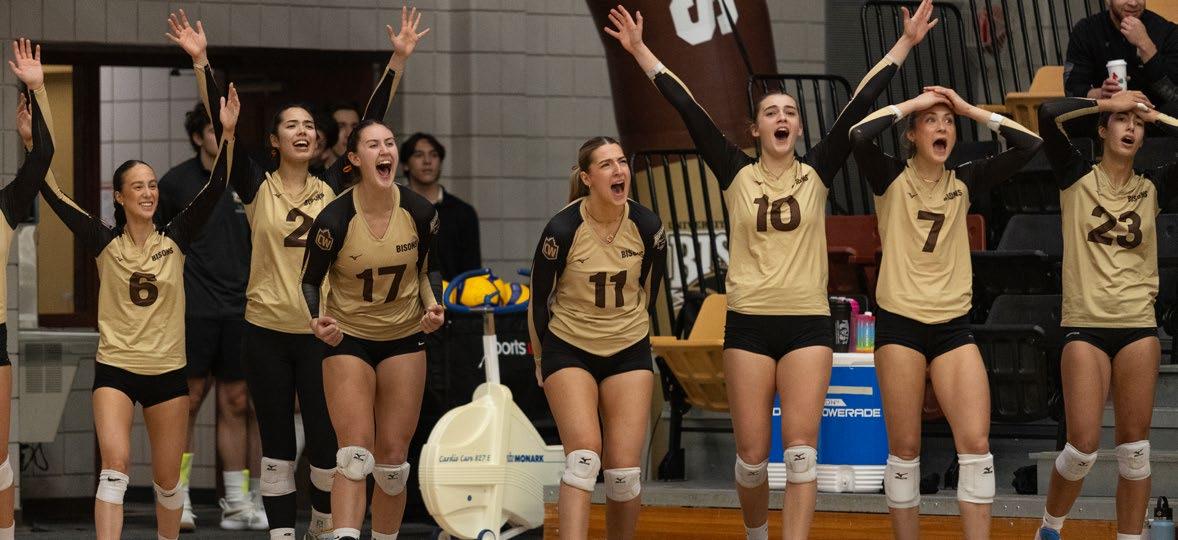
was integral to the Bisons’ victory. Equally integral was Bentley, who dished out 47 assists and played with great energy the whole match. Like Arnold, she never gave up on any balls, no matter how far she had to sprint to track them down.
The Bisons’ robust presence in the middle cannot be understated either. Eve Catojo and Brenna Bedosky combined for a total of 10 blocks and 11 kills.
Offensively, Uchechukwu and Gray lead the herd in kills with 15 each.
Likewise, Raya Surinx, who was recently awarded the dis-
tinction of CanWest women’s volleyball player of the year, also recorded 15 kills. Bentley fed the player of the year frequently — 57 times, in fact.
The Bisons’ victory over UBC marked the first CanWest championship for the Bisons’ women’s volleyball program.
Next up, the Bisons will fly to Ontario to participate in the 2024 U-Sports volleyball championships hosted by McMaster University. The herd is looking to capture its first national championship in a decade, as it last won in 2014.
Track and field
The University of Manitoba’s track and field squads competed in the yearly U-Sports championships, which took place on home turf this past week.
Women’s team
Last season, the women finished ninth at the U-Sports championships, achieving 16 points, placing just below the University of Windsor.
put for the second year in a row.
McConnell placed second in the shot put this year with a throw of 14.96 metres, significantly longer than her chuck of 14.62 metres which secured her first place at last year’s U-Sports championship.
However, her throw at the 2024 championships did not cut it, as she faced steep competition.
Ultimately, the women
looking to improve on last year’s stellar U-Sports championship results.
This U-Sports championship started off with the speedy Jordan Soufi tying for first place in the 60-metre dash with a time of 6.67 seconds, improving from his fifth-place finish last year.
The podium finishes just kept coming for the U of M, as Dawson Mann placed first in the 600-metre with a time of 1:17.78.
Looking to upgrade from 2023 U-Sports results, the women started with the field events.
Lara Denbow stood out in women’s high jump, placing first, earning a gold medal and jumping 1.78 metres.
Anna McConnell also medaled in the women’s shot
finished this season’s U-Sports championship in 10th place with 18 points, tying with the York University Lions.
Men’s team
Last year, the men’s track and field team placed third with 83.33 points.
Naturally, the herd was

The herd kicked off the weight throw with two podium finishes, with Graham Wright and Graham Hutchison-Campbell placing second and third respectively. Wright attained a throw of 19.35 metres, and Hutchison-Campbell, a throw of 18.65 metres.
Another huge performer for the Bisons at this meet was Max Speiser. Speiser won
the heptathlon with a total of 5,270 points over all seven events.
These performances netted the Bisons’ men’s team a second-place finish, moving up one slot in the standings from the previous year. The team finished with a total of 82 points.
This past week, the University of Manitoba swim team participated in the annual U-Sports championships, which yielded some fast swimming and some personal best times.
The women’s swim team started ripping up the pool last Thursday, as Ella Howe sprinted into eighth place in the 50-metre freestyle A-final with a time of 26.78. With that time, Howe qualified for the Olympic trials.
Another notable individual performance for the herd was
Kelsey Fillion’s eighth-place finish in the A-final of the 200metre freestyle, swimming a time of 2:08.91.
Fillion also performed well in the 100-metre freestyle, securing a time of 57.97, as she swam into sixth place.
The Bison women concluded the 4×100-metre freestyle with a blazing finish, as teammates Howe, Hannah Schanel, Fillion and Georgia Pengilly placed fifth and finished with a time of 3:55.70.
Overall, the women finished in ninth place at the U-Sports championships — a result it will look to improve on for next year.
The University of Manitoba swim team will next hit the pool as it starts wrapping up the season at the Western Championships, scheduled from March 21 to 24.

